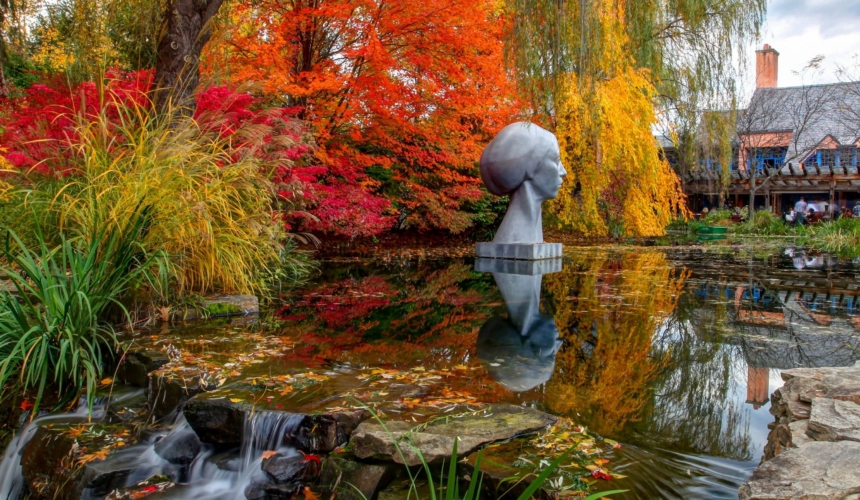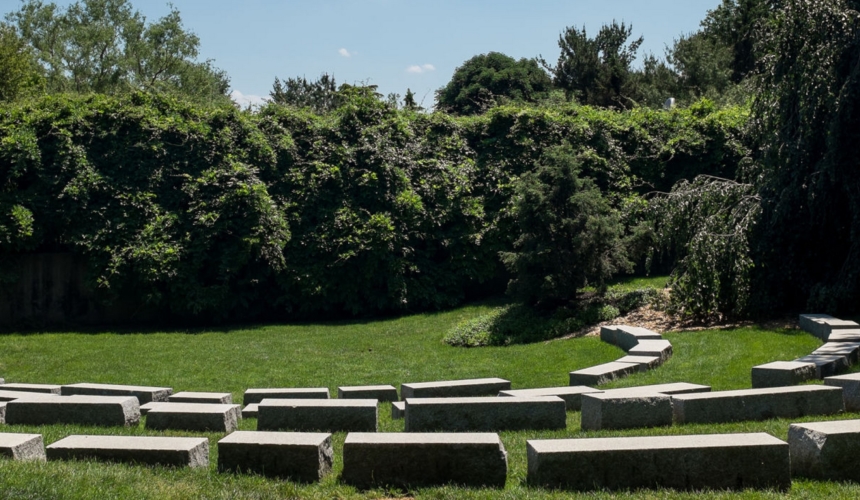Garden Features
The Johnson Atelier had a sand foundry in its early days, but when their sculpting process changed, their sand tower was no longer needed. Always on the lookout for materials to repurpose, the sand tower was re-imagined in 2008 as a “garden in the sky”. After its relocation, the top of the hopper was removed, and Dawn Redwood and Japanese Maples along with smaller plants, rocks and moss were situated at the top to complete the landscape nearly 20 feet in the air. The tower can be found on the left of the Eastern Garden, and offers a three-story view of the sculpture garden, best viewed when there is minimal leaf cover.
One of the most photographed landscape features is the Red Maple Allée. The long winding path meanders between two rows of Japanese Maple trees. During the development of the sculpture garden, these trees were found during a scouting mission for interesting plant material at an abandoned nursery in Kingston, NJ. At the nursery, the Japanese Maple trees had been planted close together and left alone to grow. These dense conditions restricted growth, forcing the trees to grow tall and leggy rather than branching outward. Their roots were so tightly intertwined that they needed to be dug out and moved in groups of five if they were to be saved. Replanted close together in two parallel rows in spring of 2002, this is an unforgettable feature of GFS at any time of year and is particularly showy in the fall as the leaves turn a brilliant red.
The architectural plan for the Seward Johnson Center for the Arts included an eastern wall made almost entirely of glass, overlooking a series of sculpture exhibition spaces created in 2003 by rows of the evergreen Yew and Osmanthus hedges, and creating a natural feature that was an outdoor extension of the building’s East Gallery. The distinct spaces which form the hedgerooms overlook a pond that was dug just beyond. These Yew hedges, inspired by those commonly grown in France, ranged from 6′ to 10′ tall at the time they were planted, and today stand many inches taller.
Rat’s Pond
Abutting the picturesque patio at Rat’s Restaurant (named one of 100 most scenic restaurants in the US), is the Rat’s Pond. Approached from the sculpture park, guests first encounter a small cascading waterfall fed by the Pond, with a view that reveals the charming French-inspired restaurant and surrounding horticulture and sculpture, including Philip Grausman’s Leucantha and David Hostetler’s Summertime Lady. The pond, built in 1999, is home to a variety of colorful Koi fish, and an ideal environment for the water lilies, iris, and other plantings contained within the water. Notice also the countless colorful blooms planted near the patio as well as weeping willows and weeping cherry trees framing the far shoreline.
Monet Bridge
The Monet Bridge overlooking the patio at Rat’s Restaurant was constructed in 1999 to recreate the scene from Monet’s famous painting, Bridge over a Pond of Water Lilies. The bridge featured in the painting can still be found today at Monet’s property in Giverny, France. At GFS, the area surrounding the bridge is planted with water lilies and weeping willow trees in order to closely replicate the painting. The Monet Bridge is a scenic location favored for photography at GFS.
The deciduous conifer collection at GFS, established in 1989 and still being developed in present day, includes Dawn Redwoods, Larches, and several types of Bald Cypress including weeping and fastigiate varieties. They can be found in several areas of the park including The Water Garden, The Meadow, Rat’s Woodlands, and adjacent to Maplehenge. The first Dawn Redwoods in the collection were transplanted to create room for the installation of Seward Johnson’s If It Were Time, and are flourishing in their current location in Rat’s Woodlands.
The Orchard was part of the original site plan. Though that plan suggested an apple orchard, the decision was made to plant crab apples instead to eliminate the more intensive maintenance required by apple trees. Two types of crab apples were planted here in 1989 – the upright ‘Strawberry Parfait’ blooms a deep magenta-pink, which fades to soft pink and then white before the petals fall, while the weeping ‘White Cascade’ trees present white blooms. The Orchard can be found on either side of the Museum Building parking lot, and lines three sides of the Museum. Depending on weather, these trees tend to bloom in mid-late April/early May. Flowers may last 7-10 days in cooler conditions.
The Warming Hut was conceived as a place to escape the cold during winter outings on the grounds. Seward Johnson envisioned an inviting room with a fireplace where groups could gather. This intimate structure was built between 2001-2002. Inside the cozy space, a gas fireplace welcomes chilled visitors. A close look at the top of the building reveals winter jasmine, goldenrod, and ornamental grasses planted on its green roof, the only roof of its kind at GFS.
Fashion designer and artist Gloria Vanderbilt and Seward Johnson collaborated to create the Forest of the Subconscious, considering every detail of the space, from its winding pathways and trees to the artwork to be included in this unique environment. The Seward Johnson Atelier enlarged one of Vanderbilt’s ‘Dream Box’ works from its original 12” cube to the 6’ work entitled Heart’s Desire that stands in the Forest of the Subconscious today. The area’s meandering pathways run between rows of weeping white pine trees and weeping Norway spruce trees. As the tree canopy grew in, an understory of shade plants was added to complete the scene. This garden opened to the public in 2008.
The concept of the Amphitheater was included in the original park plan. The ground was initially flat, so soil was dug out to create the hollow at the foot of the space. Later, the hollow was effectively split in two by a large gabion wall upon which the Wisteria Pergola was later built. Massive granite blocks frame out the space and create ample seating. The Amphitheater has served as an intimate location for concerts, events, and relaxation. A wooded glen composed of trees including river birch, katusra, weeping beech and southern magnolia, separates the Amphitheater from the rest of the park, adding to its secluded ambiance.
Built upon the gabion wall seen from The Amphitheater, the Wisteria Pergola was conceived to add more verticality to the wall while creating a unique passageway between distinct areas of the grounds. Constructed in 1995, this 230’ long natural tunnel of dense foliage and twisting branches is composed primarily of summer blooming wisteria, trumpet vine, and clematis, and allows for occasional glimpses of the sculpture garden from a uniquely elevated perspective. The footprint of this pergola was once one of the curves of the horse racing track at the NJ State Fair.
The Lotus Pond, constructed in 1989, was one of the first landscape features created at the sculpture park. Shortly thereafter the park’s founder requests that a gazebo be built adjacent to the pond with its deck at water level. This created a distinctive space in the heart of the sculpture garden. While the lotus were initially planted in pots, they have since spread to take over a large part of the pond creating a blanket of greenery and presenting huge dinnerplate-sized blooms during early summer. The Gazebo patio and two-story observation tower make great viewing platforms for the pond and beyond. During summer months, a snack stop operates out of the Gazebo, and guests can drop by for ice cream, beer, wine, and snacks.
Constructed adjacent to the Domestic Arts Building, the Water Garden was designed to create an intimate setting for small sculptures utilizing a variety of hardscape and a variety of plant material, all augmented with the element of moving water. Much of the Water Garden is below the surface – the construction of this space began 12 feet below ground level, where water circulates from the central basin to a waterfall at one end of the space and feeds two different fountain variations in other locations. Making its way through various water courses and under or around several artworks, the water meanders back to its source, in a continuous recycled flow. The Water Garden is home to our extraordinary Camperdown Elm Ulmus glabra ‘Camperdownii’. Recognized as a rarity, every Camperdown Elm is descended (through grafted cuttings) from the original tree, discovered in the early-mid 1800s in Scotland.
Acer Courtyard
Located between the Motor Exhibits Building and the Domestic Arts Building, the Acer Courtyard is a shady space for rest, outdoor dining, and concerts. The Japanese Maples (Acer palmatum) trees which create its ambiance were found in an abandoned nursery. They had been left close together and were competing for sunlight, which resulted in tall trees with sparse lower branching. Transplanted into the courtyard in the spring of 1993, these trees create the perfect canopy, providing shade in the warm months and turning brilliant red in the fall before blanketing the ground in crimson as the leaves drop from the trees.
The Acer Courtyard is constructed in a space formerly occupied by what is now the Museum Building, though in the historic Fairgrounds days, it was known as the Rabbit Building. In 1991, during the early days of construction of the sculpture park, this structure was moved to where it stands today.
Bamboo Courtyard
Landscape Designer Brian Carey was interested in planting bamboo to create intimate and natural outdoor spaces and was inspired to integrate the plant into this outdoor room. There are several different types of bamboo employed in concert with Japanese maples and other plants, creating a layered effect. Niki Ketchman’s Siren was sited here in part because of the way its form relates to the bamboo.
In 1989, just beyond the Motor Exhibit Building, we built what would become the access roadway for the loop road through Grounds For Sculpture. Inspired by scenes from Europe, it seemed like a perfect location for planting trees to form an allée. Originally planted with Lombardy poplars in 2002, which did not thrive, it was determined that the native River Birch was a more suitable choice for this climate and so the poplars were replaced in September of 2008. Today, the beautiful river birch with their warm coloring and textural bark herald visitors on the journey into the heart of the sculpture garden. In addition to creating a majestic pathway for strolling, the River Birch Allée creates beautiful moments for visitors to admire the contemporary sculptures that are sited between its trees and along its edges.















